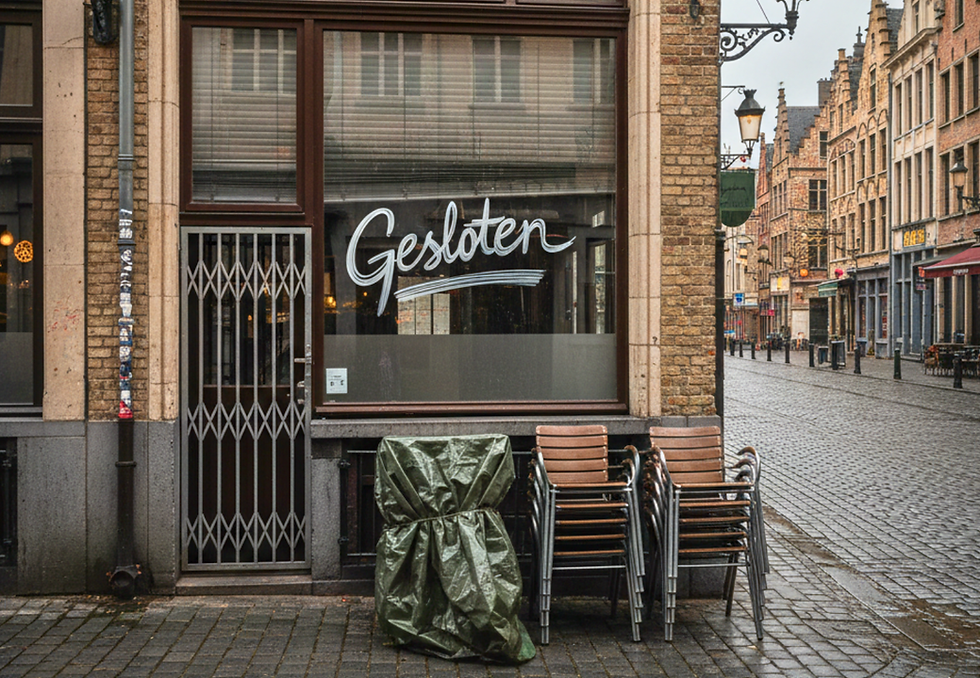In Flanders, restaurant owners are closing down more often than they are opening new establishments
- François Remy

- 5 days ago
- 4 min read
Every day, two restaurants go bankrupt while three operators cease activity. Ultimately, last year, the number of restaurateurs leaving the market symbolically exceeded the number of new entrants.

“What will the Flemish restaurant industry look like in 2025? And what challenges will entrepreneurs face?” Horeca Vlaanderen recently asked in response to the new season of the popular VTM program “Mijn Restaurant” (My Restaurant). To put the state of the market into perspective, the industry federation used figures from the Kenniscentrum Horeca (Hotel Industry Knowledge Center), based on data from Graydon.
And these statistics reflect a complex dynamic at play in Flanders since last year: the number of new businesses (1,716 in 2024), equivalent to nearly five openings per day, is lower than the number of closures (1,053 businesses ceased operations voluntarily and 672 went bankrupt). Symbolically, this represents a negative balance, compared to a slightly positive result in 2023 (45).
This highlights the fragile balance of the industry and a recurring problem of sustainability. New restaurants are popping up everywhere, but most fail in the short term, generally due to the difficulty of running a profitable business. Restaurateurs, often newcomers, find themselves facing management, profitability, and competitiveness challenges, and they don't easily overcome these obstacles.
Wage pressure weighs heavily on small businesses, which struggle to generate sufficient profit margins. Restaurateurs, often operating with insufficient financial resources, are unable to balance their expenses (salaries, rent, energy) with their revenues.
A saturated market or one in full transition?
Many novice restaurateurs have an idealistic view of the profession but lack the necessary skills in management, cost accounting, and resource optimization. This leads to fatal mistakes in the first few years of operation, as evidenced by the number of voluntary or forced closures.
This suggests that the restaurant market in Flanders is approaching a point of saturation. Voluntary closures may reflect a market readjustment. Some restaurateurs, aware of the difficulties and low margins, are choosing to cut their losses or redirect their business. In some cases, this may be due to a loss of motivation or an objective reassessment of the long-term viability of their project.
But the environment also appears deceptively favorable to new ventures, thanks to the abolition of the establishment law (2018), which no longer requires specific training and, consequently, no longer mandates adequate preparation. "The hospitality industry is synonymous with hospitality, experience, and taste. But you can't build the future on passion alone. Cost calculations, payroll estimates, and the right market positioning for your business are also essential," insists Matthias De Caluwé, CEO of Horeca Vlaanderen, while warmly recommending the Horeca Forma project, which gives young people from hospitality schools the opportunity to obtain a sector-specific entrepreneurship certificate.

The consequences of fast-foodization?
In any case, dreams of success are clashing with a harsh economic reality, which also takes the form of increased competition. While Flanders already had 15,990 establishments at the end of 2015, it had 19,523 (+22%) at the end of last year, as reported by Het Laatste Nieuws .
Even the coronavirus pandemic and the lockdowns that accompanied it apparently did not dampen enthusiasm. However, alongside the 9935 traditional, full-service establishments, there are now 9588 "fast-food" outlets, where service must be quick.
The rise of fast-casual restaurants, which are more accessible and offer good value for money, has intensified competition. These establishments, more agile and less expensive to manage, are absorbing a portion of the market, making it difficult for traditional restaurants to gain a foothold, especially if their business model is poorly designed from the outset.
“Fast food has an average margin of 15%, compared to 5% for traditional restaurants. This model, based on franchising, is easily replicable and promotes rapid expansion,” emphasized Amaury Marescaux, CEO of Gondola Foodservice , echoing the hundreds of new McDonald's, Burger King and company outlets expected before 2030.
Low sector profitability, rock-bottom survival rate... but "millionaire restaurants"
As new openings contribute to market saturation, many operators struggle to attract a qualified and stable clientele. Those who fail to differentiate themselves or meet specific demands quickly face the risk of closure.
Despite a total turnover of €13.03 billion, 62% of which is generated by restaurants, the Flemish hospitality sector remains one of the least profitable. The median net profit of businesses in Flanders was only 2.1% of turnover in 2023, compared to 8.5% across all sectors, notes Horeca Vlaanderen.
This low profitability translates into a particularly low survival rate: ten years after their launch, fewer than four restaurants are still in operation, the lowest survival rate in Flanders, across all sectors.
Behind these alarming indicators lies a kaleidoscope of exceptions. East Flanders stands out with a median operating margin of 11.1%, the highest in the country, reveals the unprecedented analysis by Gondola Foodservice, and the three most profitable restaurants in Belgium are located in the Flemish region .
“Horeca establishments show a median margin of around 30,000 euros per year. Yet, the most profitable restaurants generate millions of euros in annual profit . That is a multiple of 40 times the national median,” points out Amaury Marescaux.



